The McDivits and the McDivit "Home Place"
by Florence McDivit Casey, 1963
(A note from Michael Tormey: To those of us descended from my grandparents, Joseph Heuisler Tormey and Josephine McDivit Tormey, the colorful history of our McDivit roots is as important as our Tormey heritage. I was, in fact, raised to feel that I was as much a McDivit as a Tormey. Interestingly, too, many McDivit physical and personality traits have passed through to my generation.
The following historical narrative about the McDivits and their beloved "Home Place" was written in 1963 by my Great Aunt Florence McDivit Casey, sister of my grandmother Josephine McDivit Tormey. Although I have added photographs and edited the work slightly to correct known errors, the text appears as it was originally written 45 years ago -- thus a number of the people and places referred to might seem out of date today.)
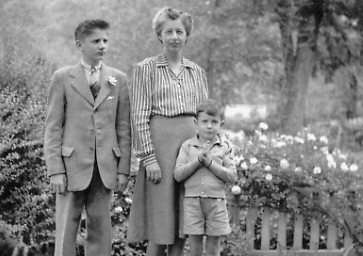
Florence McDivit Casey ("Aunt Sue", as she was known to my
father's generation) with her sons, Harry (to the left) and Bill
(to the right), c. 1941.
The McDivit Family
This
study of the McDivit Family is based on the family Bibles of James and Joseph
McDivit; upon the inscriptions on the tombstones in the peaceful little
churchyard at St. Joseph's Church in Emmitsburg, Maryland; upon the clear-headed
recollections of my father's only surviving brother, Dr. Harry N. McDivit, who
was ninety-one years old on January second of this year, 1963; and also from the
impressions which I picked up through the years from the conversations of the
members of my father's generation. These facts and reminiscences gave me a
background for questions which cannot all be answered without genealogical
research, especially those prior to the time of James and Sally Wise McDivit, my
great-grandparents. Perhaps there will be someone in the generations to
follow us who will be interested in visiting courthouses and county-seats and in
filling out the earlier records.
The McDivit "Home Place"
What little we know about the
family centers around Emmitsburg, Maryland. There the McDivit Home
Place may still be seen. The substantial and attractive stone house
was occupied (1956) by a tenant of the owner, Gwynn Topper, who also owns the
orchards on either side of the main road as you approach the house. It was
sold by the McDivit family soon after the death of Joseph P. McDivit, the
grandfather of my generation. He died September 7, 1875 and according to
Uncle Harry the family lived there five years or so after that. Another of
my father's brothers, Uncle Joe, said the family would probably never have lost
the property if grandmother's sons had been old enough to protect her interests.
Emmitsburg was once called
Emmits Town. According to Uncle Harry, the old Home Place, as my
father always called it, was part of Carrolsburg, and I have wondered if this in
turn was connected with Carrolton Manor, a huge tract of land which had been
acquired by Charles Carroll of Carrollton. Incidentally, the McDivit
property was divided by the Mason Dixon Line -- part of it being in Maryland and
part in Adams County, Pennsylvania. At what period the McDivit
family acquired the land and how extensive their holdings were we do not know.
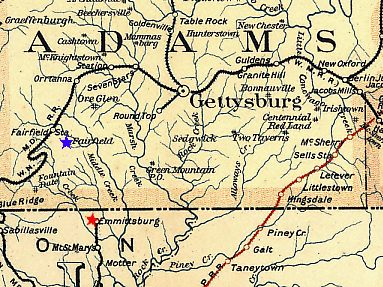
Sectional
excerpt from a Rail Road Map of Pennsylvania,
published by the Department of Internal Affairs of Pennsylvania
in 1895. (Library
of Congress, Geography and Map Division.
Original print 87 x 141 cm. Digital ID g3821p rr002970.)
Adams
County, PA is to the north and Carroll County, MD
is to the south (divided by the Mason Dixon Line). Emmitsburg
is highlighted with a red star; Fairfield is highlighted with a
blue star. Note the close proximity of Gettysburg in
Adams County, just to the northeast.
Uncle Harry believes the
existing stone house was built by his father, Joseph P. McDivit, and says that
his sister and brothers were all born there. James McDivit, the father of
Joseph, was born in the "old mill house" which sat on a little hill
above the mill, and there he raised his family of nine children (see Bible
record).
In determining the exact age of
the house, it would be interesting to know if it was actually built by James or
by his son, Joseph. James died in 1858, at the age of seventy-six, and
Joseph died in 1875, at the age of fifty-eight. There is an interval of
seventeen years between their deaths, with the disruption of the Civil War
(1861-1866) during this period. (With Gettysburg so close at hand, it was
impossible for the family to remain untouched by the war.) Research may
settle these questions some day.
The old home may be reached
from Baltimore by Route 140 to Westminster and then over Route 97 to Emmitsburg.
Drive straight through the town to the Emmit House (old when I was young); take
the fork to the right; go one and a half to two miles; the house is on the left
just before Tom's Creek. It is a stone house with colonial columns and a
porch or gallery straight across the second floor. There is an old stone
building beyond the house (possibly a mill). A creek is lower down.
It once formed the mill race, but there was little water in it the day we were
there, due to the clearing of a heavy stand of timber from the mountains nearby.
Uncle Harry says there was an
L-shaped addition to the right rear of the house, the second floor of which was
used for a school for the McDivit children. Miss Belle Kidgely was the
teacher and he remembers her very well. She married later and lived in
Baltimore.
The Home Place was
designed to take care of the needs of the family and to provide additional
income as well. Uncle Harry drew a rough sketch of the farm layout which
is the basis for the following description...
To the back and left of the
house was a very large wagon shed open at both ends and with corn cribs on
either side. To the right and beyond a paling fence was a springhouse, the
refrigerator of that period, with a trough for cooling milk. Still further
to the right was a big bank-barn which burned down in later years. Behind
the house was the ever essential well. Lovely
large boxwoods and trees were near the house. A beautiful walnut tree,
which "has never born nuts" according to its present occupants, is at
the left of the house and a big ash tree near the springhouse was a favorite of
Uncle Harry's. He also remembered the fenced-in vegetable garden some
distance behind the house, as well as the chicken house. Then there was a
hill, and down in the hollow beyond was the mill race with the mill for grinding
grain raised on the farm (thus providing food for the family as well as for the
animals). Oak bark, preferably white oak, was stored on the hill to be
used in the tannery which was a level triangular spot beyond the mill and close
to the junction where Friend's Creek (also called Mountain creek) ran into Tom's
Creek, thus feeding the mill race. The cattle, and probably the hogs as
well, provided hides for the tannery which had two vats. In addition to
all of this, I can remember my father speaking of a sawmill which must have been
a necessity in such an operation.
The Clarence Alexander family
lived in the house in 1956. They gave their address as Fairfield, Route 2,
Pennsylvania. They spoke of the small house just back of the main house as
the old slave quarters. Ike Downey, a former slave, worked for the
McDivits. His widow lived on the road to Emmitsburg according to the
Alexanders. We tried to contact her on the way home but were
unsuccessful. Older generations of Alexanders had also worked for them.
Uncle Harry says the house in
which Mr. Topper lives was once a country store. The McDivit children
delivered eggs there in exchange for groceries. Barter was not unusual at
this time, particularly in the country.
Views of the McDivit Home Place Throughout the Years
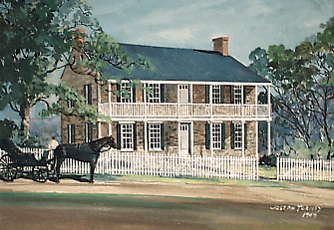
A 1969 oil painting by Joseph Heuisler Tormey,
Sr.,
depicting the McDivit Homestead as it appeared at the
end of the nineteenth century.
A view of the main house as it appeared in
September, 1901, as photographed by John A. McDivit
and Florence Hartman McDivit on a trip to Emmitsburg.
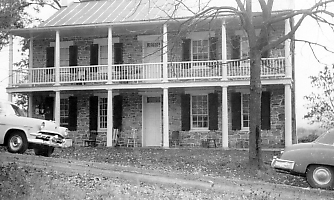
A view of the home as it existed in 1956
(photo by Florence McDivit Casey).

A more modern view of the home, as it appeared in 2002
(photo by Michael Tormey).
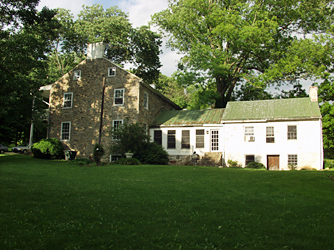
A view from the right hand side of the home, also in 2002
(photo by Michael Tormey).
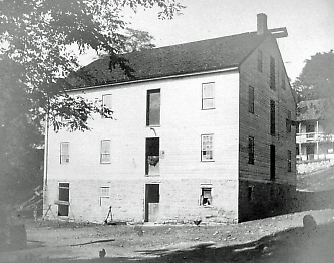
A view of the flour mill (located down the hill
behind
the main house), as it appeared in September, 1901,
as photographed by John A. McDivit and Florence
Hartman McDivit on a trip to Emmitsburg.
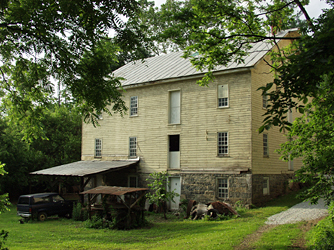
A view of the flour mill as it appeared in 2002
(photo by Michael Tormey).
Changing Times
[Life for the McDivits changed
dramatically following the death of Joseph P. McDivit, who died suddenly in
1875, at the age of 58.] Grandmother must have been
overwhelmed by her responsibilities following the loss of her husband. To
be left a widow at forty-three with six children, ranging in age from ten years
to fifteen months, was indeed a tremendous problem. The additional
necessity of successfully running the family farm was doubly overwhelming. Her
brother, Felix Diffendal, returned from the Midwest, where he had settled, to be
with his sister. Apparently, his assistance was not sufficiently able to
make the farm pay, however, and the family had to dispose of it. Life was a struggle
for them in those early days, but Grandmother had reason to feel happy at the
results. She was very proud of the McDivit name. (Uncle Harry once
teased her about it.) She said she was not proud for herself but for her
children. Unfortunately, Uncle Felix destroyed all the family records,
saying that they were of no further value.
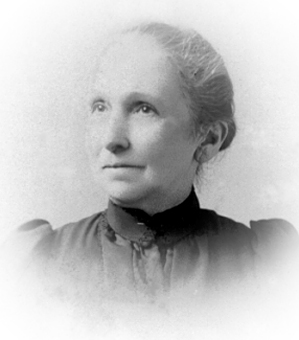
Mary Josephine Diffendal McDivit
("Grandmother McDivit"), c. 1900.

Felix Diffendal ("Uncle Felix"),
Grandmother McDivit's brother (who was
8 years her junior), c. 1885-1890.
Uncle Harry commented on the
freedom Grandmother allowed her sons, sending them off to gather wild berries
even when they were quite young and putting no firm regulation on how far they
could go or in what direction. Thus they enjoyed the freedom to explore
the country around them and to learn the lessons of nature. They fished in
the streams and when they reached sufficient age were allowed to have guns for
hunting rabbits and other small game. The physical, mental and moral
training of their boyhood enabled them to become self-sufficient men of
character, well able to take their places in the cities to which they gravitated.
The McDivit children continued
their education in Emmitsburg at St. Euphemia's School run by the Sisters of
Charity -- receiving the limited education which small towns all over America
provided in those days (but they lived in an era when this was usual and all of
them were a credit to their mother and their forebears). Mary Angela (Aunt
Mame) attended St. Joseph's Academy, now St. Joseph's College, in Emmitsburg,
which was founded by Mother Seton, now on her way to sainthood. Uncle
Jimmy [James Vincent McDivit] went to Baltimore to seek a wider field than Emmitsburg provided.
Uncle Joe [Joseph McDivit], having attended Niagara University in New York state for two years,
settled in Frederick. Uncle Pete [Peter Philip McDivit] went west and made St. Joseph, Missouri
his home. Uncle Harry [Harry Norbet McDivit] came to Baltimore, followed by my father,
John [John Albert McDivit], the
youngest son.
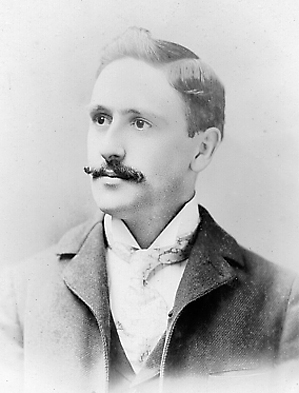
Harry Norbet McDivit ("Uncle Harry"),
whose
recollections later in life contributed to this
narrative, c. 1900.
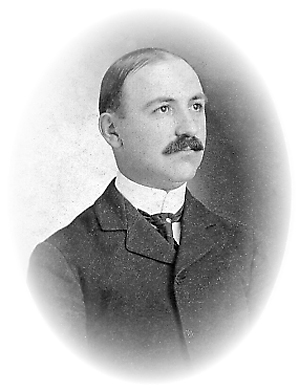
Peter Philip McDivit ("Uncle Pete"),
who
migrated west to Missouri, c. 1905.
In time, Uncle Jimmy became the
president of a large spice company, the William N. Crawford Co. Uncle Joe
became vice president of the Citizen's National Bank in Frederick. Uncle
Pete was vice president of the John S. Brittain Co., a wholesale dry goods
company in St. Joseph, Missouri. Uncle Harry studied dentistry at the
University of Maryland and practiced successfully in Baltimore until
retirement. John McDivit became president of the Henry H. Meyer Co., a
concern which sold construction and industrial equipment.
The unmarried brothers provided
for their mother and sister as long as they lived. Uncle Jimmy lived with
them and Uncle Joe came down from Frederick frequently. The nearby
grandchildren visited Grandmother's often. The other sons, Harry and John,
lived not far away and stopped by regularly -- not through a sense of duty, but
because they were devoted to their mother. Uncle Pete never failed to
visit twice a year on his way to New York, where he did his buying for the
Britain Company. His arrival always signaled a get-together at
Grandmother's and young and old enjoyed the gay banter of the fun-loving McDivit
boys. Grandmother was next door to heaven when they were all around
her. She was a gentle, refined little lady, slender in her black silk
dress.
The St. Joe McDivits spent
summers here on two occasions, visiting at Grandmother's, at Uncle Harry's and
at our house in West Forest Park. It gave us all a chance to know Aunt
Helene [Helene Herrick McDivit], Herrick [J. Herrick McDivit] and
Philip [Peter Philip McDivit III]. I was the oldest of the grandchildren.
My sister, Mary Josephine ("Mate"), came next, with Herrick following
her three months later. Mary Louise (Uncle Harry's daughter) was next in
line. Philip, Margaret (another of Uncle Harry's daughters) and my
brother, John A. McDivit, Jr., were all born the same year. Sadly, a small
son of Uncle Harry's, Harry Norbet McDivit, Jr., died in infancy. These
formed the list for this particular generation. Since my brother never
married, the McDivit surname has disappeared here in the east, as far as our
immediate family is concerned. We must depend on the children of Herrick
and Philip, both deceased at an early age, to carry on the name in the Midwest
where they now live.
After leaving the old Home
Place, the McDivits lived at Valley House on the road to Gettysburg, and
then at the Baker House on the Pike. As soon as feasible, Grandmother and
Aunt Mame joined the sons in Baltimore at 3000 N. Calvert Street. Later
they moved to 2415 Maryland Avenue, which was headquarters for the family for
many years until the neighborhood had deteriorated and Grandmother, Uncle Jimmy,
Aunt Mame and Uncle Joe had all found a resting place with their ancestors in
the little churchyard in Emmitsburg.
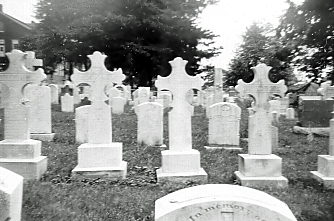
McDivit family gravestones (the ones with the Celtic crosses)
at the St. Joseph's
Church cemetery in Emmitsburg, MD.
Photo, c. 1945.
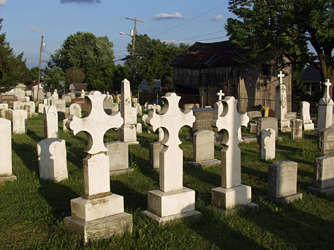
McDivit family gravestones as they appeared in 2002.
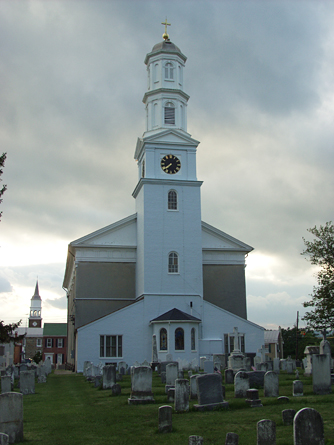
A view of St. Joseph's Church, as it appeared in 2002.
Older Generations
James
McDivit was the Justice of the Peace for the surrounding countryside and was
known as the Honorable James McDivit.
Joseph P. McDivit might
be termed a gentleman farmer, riding horseback as he managed the work on his
farm. He also dabbled in politics. Uncle Harry said he did not drink
but provided a decanter on the sideboard for those who did. He was
hospitable and they frequently entertained at dinner the priests from St. Mary's
College who came over the "back road" on horseback. he had great
ambition for his sons, planning to educate them for the professions.
Grandmother, Mary Josephine
(Diffendal) McDivit, was born in Libertytown, not far from Frederick.
In addition to her brother Felix, she had another brother, Sam, who developed an
extensive peach farm in Smithsburg, Pennsylvania. There were others in her
family, among them the Diffendals of Frederick and of Philadelphia.
Sally Wise, wife of our
great-grandfather James, was born in Conawaga, Pennsylvania, which is near
McSherrystown, in Adams County. Uncle Harry says there is a long line of
Wise family tombstones in the churchyard at Conawaga. These we hope to see
when we go to Emmitsburg and Conawaga on a trip which my husband and I are
planning for this spring, taking Uncle Harry along if possible. He says
that Conawaga was a Jesuit settlement and that the first church was a log church
situated on a hill and dedicated to the Sacred Heart. (It was from
Conawaga that many settlers started west, following the trail along the Monacacy
River.) There was a block house there as a protection against the Indians
who kept returning to the springs for water. The Sneeringer family lived
there and later gave it to the government.
The McDivit Name
Incidentally, the spelling of
the name has sometimes been questioned. Our authority is found in the
graveyard at St. Joseph's Church in Emmitsburg, where about fifteen of our
ancestors are buried. (The eldest, Philip McDivit, was born in
1746.) I will list them all as a matter of record later on in this study.
The name has been retained here
in Baltimore by my sister's son, John McDivit Tormey, now a doctor doing
research at Johns Hopkins Hospital and by his son, John McDivit Tormey, Jr.,
just a year old at this writing (1963). It has also been perpetuated by my
grandson, Thomas McDivit Casey (who will soon be ten years old), the oldest son
of Harry J. Casey, Jr. -- the only one of the four grandchildren of John McDivit
who was old enough to remember him.
Names Copied From Gravestones at St. Joseph's Church Cemetery, Emmitsburg, Maryland
(as copied by Florence McDivit Casey, July 12, 1956)
Name |
Date of Death |
Age at
Death |
Date of
Birth |
Philip McDivit |
May, 1825 |
79 |
1746 |
Henry McDivit |
7-15-1843 |
65 |
1778 |
James McDivit |
1858 |
76 |
1782 |
Catherine McDivit |
1835 |
34 |
1801 |
Sarah McDivit |
3-01-1859 |
53 |
1806 |
Mary McDivit |
1872 |
57 |
1815 |
Joseph P. McDivit |
1875 |
58 |
1817 |
Jane McDivit |
1860 |
41 |
1819 |
Martha McDivit |
1888 |
58 |
1830 |
Julia J. McDivit |
1889 |
56 |
1833 |
Mary J. McDivit |
1916 |
83 |
1832 |
Felix Diffendal |
11-06-1916 |
76 |
12-04-1840 |
Mary Angela McDivit |
1939 |
75 |
1864 |
James V. McDivit |
1922 |
56 |
1866 |
Joseph McDivit |
1941 |
72 |
1869 |
Knowledge from Gravestones
Without further records, it is
impossible to trace the father-son relationship with certainty beyond James, who
married Sally Wise. Who was his father? The Bibles provide no
clues. The gravestones only provide room for conjecture. Records at
St. Joseph's Church might help.
You will find that James was born in
1762. Henry, born in 1778, was probably his brother. Then there is
the oldest of them all -- Philip -- born in 1746. He could have been the
father of James and Henry, being thirty-six when James was born and thirty-two
when Henry was born. Or, he could have been their uncle. We are not
certain. [Note: Further research has
revealed that Philip McDivit was indeed the father of James and Henry as well as
two daughters, Catherine and Mary Jane.] You will notice how the names James, Henry, Joseph, Philip, Peter
and now John recur through the generations, making it difficult to clarify the
generations to the casual reader of this history.
On the gravestones you will find two
others: Catherine, born in 1801, and Sarah, born in 1806. These
dates antedate the Bible records of James, so they may have been Henry's
children. The first child of James was born in 1815.
There is a family tradition that one
of the McDivits was a captain in the Revolutionary War. Philip was the
name mentioned and this is strengthened by the birth date on his tombstone --
1746 -- this being the only one buried who was eligible by age to have had this
distinction. (When my brother, John A. McDivit, Jr., enlisted in World War
II we teasingly told him that he would have to do better than that. He
did, becoming a major in the Air Force and holding a temporary lieutenant colonelcy.
He served in China with the Flying Tigers and after the War he gave further
service in the occupation forces in Japan.)
It is evident that many of early
McDivits were not buried in the churchyard. Possibly some of them were
buried on their own property, which is reputed to have been extensive.
Such graves have a tendency to disappear with the passage of time.
Notes from the Bible of James McDivit -- as copied by Dr. Harry Norbet McDivit
(as copied by Margaret McDivit Canaday as of 1963)
James McDivit to Sally Wise |
1-17-1814 |
Michael Corey to Catherine McDivit |
1-19-1826 |
Joseph McDivit to Mary Diffendal |
5-18-1863 |
| BIRTHS -- children of James & Sally Wise
McDivit |
Mary McDivit |
3-15-1815 |
Joseph McDivit |
5-04-1817 |
Jean McDivit |
3-24-1819 |
Catherine E. |
7-21-1821 |
Sarah Ann |
10-03-1823 |
Rosamund Josephine |
10-24-1825 |
Henry |
12-01-1827 |
Martha |
7-03-1830 |
Julia |
1-09-1833 |
Sarah* |
3-1-1859 |
Catherine E. |
2-14-1855 |
James McDivit |
1866 |
Jean Reilly |
7-24-1816 |
Philip* |
5-12-1825 |
Henry* |
7-15-1843 |
Hon. James* |
11-13-1858 |
Sarah J. |
-- |
Catherine Corey |
1-25-1858 |
Jane* |
9-15-1860 |
Sara Rider |
2-08-1870 |
Mary* |
11-14-1872 |
Joseph P*. |
9-07-1875 |
Martha* |
8-01-1888 |
Julia* |
11-02-1889 |
*buried at St. Joseph's Church
Cemetery, Emmitsburg, Maryland.
Reflections on the List of Deaths Entered in James' Bible
Another James died in 1866, eight
years after the Hon. James. Was he his uncle? Our Uncle Jimmy was
born the same year. Then there was Henry, born in 1778, died 1843, and
buried in the churchyard. [Note:
This Henry, 1778-1843, was the brother of James McDivit, 1782-1858.] Another Henry, our grandfather's only brother,
is not buried there, nor is there any mention of his death in the Bible.
The Catherine Corey mentioned in the Bible was possibly a sister of James, since
she was too young to be his daughter.
Notes from the Bible of Joseph P. McDivit-- as copied by Dr. Harry Norbet McDivit
(as copied by Margaret McDivit Canaday as of 1963)
Name |
Born |
Died |
Mary Angela* |
3-31-1864 |
7-18-1939 |
James Vincent* |
5-24-1866 |
3-31-1923 (?) |
Peter Philip |
10-31-1867 |
2-21-1953 |
Joseph* |
8-04-1869 |
7-04-1941 |
Harry N. |
1-02-1872 |
|
John A. |
6-07-1874 |
3-29-1938 |
*buried at St. Joseph's Church
Cemetery, Emmitsburg, Maryland.
Editor's Notes
(Michael Tormey)
Modern day
McDivits and McDivit descendants owe much gratitude to Florence McDivit Casey,
whose detailed work brings to life the dynamic past of our McDivit
forebears. May this web page serve as a tribute to her valuable
contribution, preserved for many generations to come.
As an addendum,
I am pleased to report that the McDivit name has indeed carried on, through the
descendants of Peter Philip McDivit who moved west from Maryland to St. Joseph,
Missouri sometime before 1900. Perhaps we will be fortunate enough to
someday meet and reminisce about generations past.
If you feel you
might be related to our McDivit line, or if you have information that might help
fill in some of the blanks of our current research (especially about earlier
generations), I invite you to contact me by email.
|